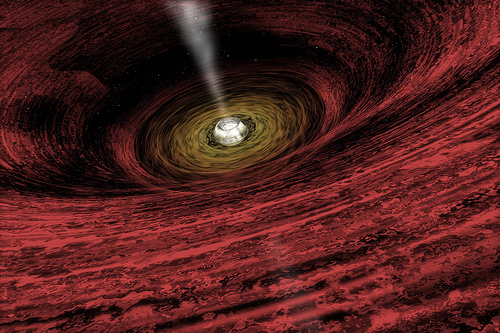
This is an open question to anyone who might understand astrophysics better than me (which is probably most of the human race).
Assume there is a really big black hole. So large, in fact, that its event horizon is more than one light-year across. If you do the sums, the gravitational force near the event horizon of such a large black hole would roughly be about 1g – the same as what it is on earth.
Imagine coming close to this event horizon in a spaceship. It would be easy to accellerate away – after all, the gravitational force in the vicinity is only 1g. So any imaginary spaceship capable of escaping the gravity of earth – if it were near the event horizon of this super massive black hole, would be able to escape its gravity.
One of the horrors you normally hear about black holes is the tidal forces that would “tear you apart”. This is caused by the difference in gravitational forces as you move closer to center of gravity of the black hole. The same thing happens near neutron stars. Your head is being pulled with a lesser force than your feet. So you get “stretched”. But in our thought experiment, the centre of gravity of our supermassive black hole is over a light-year away. My head won’t feel any different amount of attraction than my feet would. There would be no noticeable tidal forces to speak of.
So imagine you’re sitting in your late-model spaceship, orbiting just outside the event horizon of this super-massive black hole. You don’t feel any tidal forces, and the black hole is exerting a similar gravitational attraction on your vessel as what you’d experience orbiting the earth.
Apart from the huge black sphere blocking half of the sky, and the strange lense-like effect of light bending as we look across the horizon of the black hole to the numerous stars in the distance, there’s nothing to be afraid of is there?
My point is it would only take a reasonable amount of thrust to move our vessel away from the black hole.
BUT… imagine as we sit near the event horizon, we move slowly towards it until we have moved INSIDE it. What would happen? What would we experience? My meagre understanding of physics leads me to think that the escape velocity just outside the event horizon would be slightly less than the escape velocity just inside the event horizon.
So the burning question then is why couldn’t you escape from this super-massive black hole, having visited the forbidden area just inside the event horizon? The gravitational attraction at this distance would be small enough for our ship to thrust away.
And this leads me to another question. If the gravitational force near this super-massive event horizon is about 1g, why couldn’t light escape from an object just inside the event horizon? And if light could escape, would there even be an event horizon? The “Black Hole” appearance of this thing is based on the assumption that no light can escape from it because the required escape velocity exceeds the velocity of light.
So please help me. I obviously know nothing about black holes. I must be making an incorrect assumption. I don’t mind asking stupid questions, and am hoping that a patient genius will take the time to reply and explain where I’m going wrong.
Thanks in advance 🙂
Update
Since I know so little about astrophysics I decided to pull together some formulas to demonstrate what I’m talking about.
First of all a few facts about black holes. For any black hole:
- The escape velocity at its event horizon is “c” – the velocity of light in a vacuum – about 3 x 10 ^ 8 metres per second.
- The radius of its event horizon (known as the “Schwartzchild Radius”) is directly proportional to the mass of the black hole.
- The gravitational accelleration at any given distance from its centre is directly proportional to the mass of the black hole but inversely proportional to the square of the distance.
Here are a few formulas:
Schwartzchild Radius, rs = 2Gm / c2, where G is the Gravitational Constant, m is the mass of the black hole, and c is the velocity of light in a vacuum.
Gravitational Acceleration, a = Gm/r2
This means we can work out how big the event horizon of a black hole will be if we know its mass. And we can work out what the gravitational acceleration will be at any given distance from a black hole if we know its mass.
This allows us to ask the question, is there any mass of a black hole at which the gravitational acceleration at the event horizon will be similar to what we experience on earth (10 m/s2)?
I think there is.
Lets assume there’s a galaxy about 50% larger than our Milky Way galaxy. It would have a mass very roughly equal to about 1.5 x 1012 solar masses.
If we squashed this galaxy down into a small enough pile, so that it became a black hole, its Schwartzchild Radius, rs, would be about 4.5 x 1015 metres, or about 1/100th of a light year.
If we stand 1/100th of a light year from this object, what would its gravitational acceleration be? Using the above formula for a,we arrive at 10 m/s2.
The bottom line of all this rambling is that hypothetically I think you can have a black hole where the gravitational acceleration at the event horizon is similar to the acceleration that an object would experience at sea level here on earth. That black hole would have a mass of 1.5 x 1012 times that of our sun. And that means the question I raised at the start of the article is a valid one.
